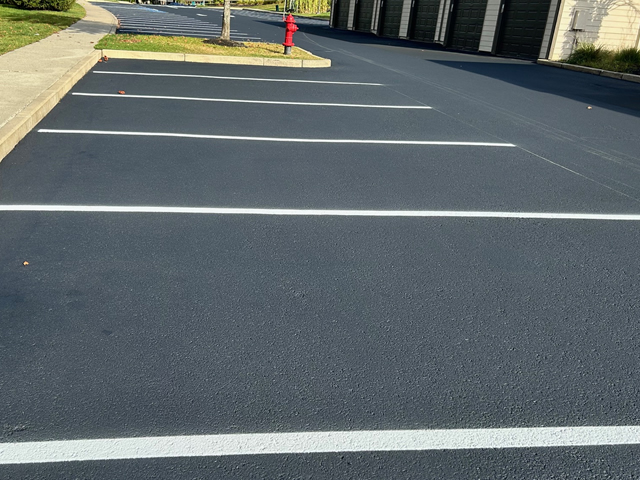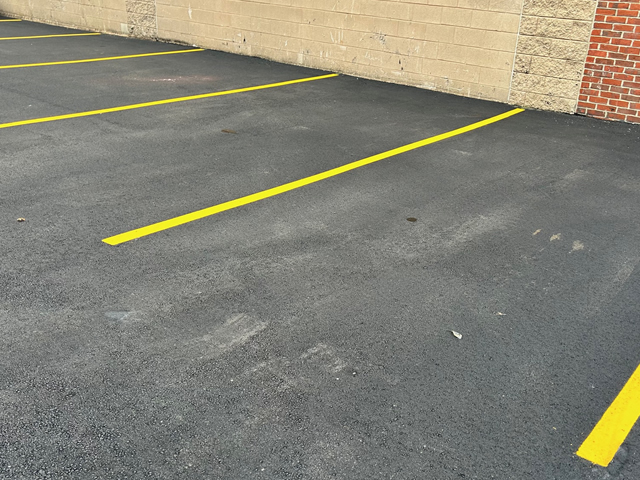What is Parking Lot Striping Called?
Parking lot striping is commonly called “line striping” or “pavement marking.” It refers to the process of painting lines, symbols, and markers on parking lot surfaces to organize traffic flow and designate parking spaces, ensuring safety and compliance.
Detailed Overview: What is Parking Lot Striping?
Parking lot striping involves applying painted lines, directional arrows, handicapped symbols, and other markings on the surface of a parking lot. These markings serve several purposes: they guide vehicles, maintain order, maximize parking efficiency, and ensure compliance with ADA (Americans with Disabilities Act) regulations. Business owners rely on these services to enhance the appearance of their property while improving safety for drivers and pedestrians.


Is Parking Lot Striping the Same as Pavement Marking?
Yes, parking lot striping falls under the broader category of pavement marking.
Pavement marking includes not only parking lot lines but also crosswalks, road centerlines, stop bars, and other traffic-related markings found on streets and paved areas.
Why is Parking Lot Striping Important for Business Owners?
Well-maintained parking lot striping ensures:
- Traffic Flow: Clearly defined lanes reduce congestion and direct traffic safely.
- Parking Efficiency: Organized parking spaces optimize the number of vehicles the lot can accommodate.
- Safety Compliance: Properly marked areas ensure pedestrian safety and adherence to local regulations, including ADA requirements for accessible parking.
- Professional Appearance: A freshly striped lot gives a polished and professional impression, attracting customers and minimizing liability risks.
How Often Should a Parking Lot Be Restriped?
Parking lots should typically be restriped every 1-2 years, depending on weather exposure, traffic volume, and the quality of the original paint. Fading lines can lead to confusion, accidents, and potential fines for non-compliance with safety regulations. Some business owners opt to schedule restriping before peak seasons to maintain a clean and safe appearance.
What Types of Paint Are Used in Parking Lot Striping?
The most common types of paint for striping are water-based acrylic paint and chlorinated rubber paint.
- Water-based acrylic paint is environmentally friendly, dries quickly, and works well in moderate climates.
- Chlorinated rubber paint offers enhanced durability and is ideal for areas exposed to heavy traffic or extreme weather conditions.
What Are the Key Elements of Professional Parking Lot Striping?
Professional parking lot striping includes:
- Straight, precise lines for each parking space
- ADA-compliant handicapped spaces and symbols
- Directional arrows for guiding vehicles through lanes and exits
- Fire lane markings to maintain safety compliance
- Crosswalks and pedestrian zones to enhance safety
When is the Best Time for Parking Lot Striping?
The ideal time for parking lot striping is during mild weather conditions when the surface is dry. Spring and fall are often the best seasons, as temperatures are more stable, ensuring the paint adheres properly. Striping should also be scheduled during off-peak hours or non-business days to avoid interruptions and traffic congestion.
What Happens if Parking Lot Lines are Not Maintained?
Failing to maintain parking lot striping can result in:
- Accidents and injuries from unclear traffic direction or faded crosswalks.
- Customer frustration due to disorganized parking spaces.
- Fines for non-compliance with ADA requirements or fire lane regulations.
- Poor curb appeal, which may negatively impact customer perception.
Parking lot striping, also known as line striping or pavement marking, plays a critical role in the safety, efficiency, and appearance of parking lots. Business owners must regularly maintain these markings to comply with regulations, prevent accidents, and create a positive first impression for customers. Choosing the right paint and scheduling timely restriping can extend the life of your parking lot and ensure smooth traffic flow.

